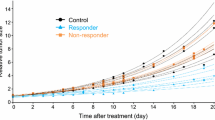Abstract
Purpose
Positron emission tomography (PET) and diffusion-weighted MRI (DW-MRI) were used to characterize the treatment effects of the MEK1/2 inhibitor selumetinib (AZD6244), docetaxel, and their combination in HCT116 tumor-bearing mice on the molecular level.
Procedures
Mice were treated with vehicle, selumetinib (25 mg/kg), docetaxel (15 mg/kg), or a combination of both drugs for 7 days and imaged at four time points with 2-deoxy-2-[18 F]fluoro-D-glucose ([18 F]FDG) or 3′-deoxy-3′-[18 F]fluorothymidine ([18 F]FLT) followed by DW-MRI to calculate the apparent diffusion coefficient (ADC). Data was cross-validated using the Pearson correlation coefficient (PCC) and compared to histology (IHC).
Results
Each drug led to tumor growth inhibition but their combination resulted in regression. Separate analysis of PET or ADC could not provide significant differences between groups. Only PCC combined with IHC analysis revealed the highest therapeutic impact for combination therapy.
Conclusion
Combination treatment of selumetinib/docetaxel was superior to the respective mono-therapies shown by PCC of PET and ADC in conjunction with histology.





Similar content being viewed by others
References
Judenhofer MS, Wehrl HF, Newport DF et al (2008) Simultaneous PET-MRI: a new approach for functional and morphological imaging. Nat Med 14:459–465
Zhang J, Yang PL, Gray NS (2009) Targeting cancer with small molecule kinase inhibitors. Nat Rev Cancer 9:28–39
Wang Q, Zorn JA, Kuriyan J (2014) A structural atlas of kinases inhibited by clinically approved drugs. Methods Enzymol 548:23–67
Yeh TC, Marsh V, Bernat BA et al (2007) Biological characterization of ARRY-142886 (AZD6244), a potent, highly selective mitogen-activated protein kinase kinase 1/2 inhibitor. Clin Cancer Res 13:1576–1583
Sebolt-Leopold JS, Herrera R (2004) Targeting the mitogen-activated protein kinase cascade to treat cancer. Nat Rev Cancer 4:937–947
Adjei AA (2001) Blocking oncogenic Ras signaling for cancer therapy. J Natl Cancer Inst 93:1062–1074
Haass NK, Sproesser K, Nguyen TK et al (2008) The mitogen-activated protein/extracellular signal-regulated kinase kinase inhibitor AZD6244 (ARRY-142886) induces growth arrest in melanoma cells and tumor regression when combined with docetaxel. Clin Cancer Res 14:230–239
Chen Z, Cheng K, Walton Z et al (2012) A murine lung cancer co-clinical trial identifies genetic modifiers of therapeutic response. Nature 483:613–617
Janne PA, Shaw AT, Pereira JR, et al. (2012) Selumetinib plus docetaxel for KRAS-mutant advanced non-small-cell lung cancer: a randomised, multicentre, placebo-controlled, phase 2 study. The lancet oncology
Jaiswal BS, Janakiraman V, Kljavin NM et al (2009) Combined targeting of BRAF and CRAF or BRAF and PI3K effector pathways is required for efficacy in NRAS mutant tumors. PLoS One 4:e5717
Sotak CH (2004) Nuclear magnetic resonance (NMR) measurement of the apparent diffusion coefficient (ADC) of tissue water and its relationship to cell volume changes in pathological states. Neurochem Int 45:569–582
Mannheim JG, Judenhofer MS, Schmid A et al (2012) Quantification accuracy and partial volume effect in dependence of the attenuation correction of a state-of-the-art small animal PET scanner. Phys Med Biol 57:3981–3993
Jordan BF, Runquist M, Raghunand N et al (2005) Dynamic contrast-enhanced and diffusion MRI show rapid and dramatic changes in tumor microenvironment in response to inhibition of HIF-1alpha using PX-478. Neoplasia 7:475–485
Honndorf VS, Schmidt H, Wehrl HF et al (2014) Quantitative correlation at the molecular level of tumor response to docetaxel by multimodal diffusion-weighted magnetic resonance imaging and [18 F]FDG/[18 F]FLT positron emission tomography. Mol Imaging 13:1–12
Holt SV, Logie A, Odedra R et al (2012) The MEK1/2 inhibitor, selumetinib (AZD6244; ARRY-142886), enhances anti-tumour efficacy when combined with conventional chemotherapeutic agents in human tumour xenograft models. Br J Cancer 106:858–866
Beloueche-Babari M, Jamin Y, Arunan V et al (2013) Acute tumour response to the MEK1/2 inhibitor selumetinib (AZD6244, ARRY-142886) evaluated by non-invasive diffusion-weighted MRI. Br J Cancer 109:1562–1569
Iwamoto M, Kawada K, Nakamoto Y et al (2014) Regulation of 18 F-FDG accumulation in colorectal cancer cells with mutated KRAS. J Nucl Med 55:2038–2044
Hirose Y, Kaida H, Ishibashi M et al (2011) Glucose transporter expression of intraductal papilloma of the breast detected by fluorodeoxyglucose positron emission tomography. Japanese J Radiol 29:217–221
Keen H, Pichler B, Kukuk D, et al. (2011) An evaluation of 2-deoxy-2-[(18)F]fluoro-D-glucose and 3′-deoxy-3′-[(18)F]-fluorothymidine uptake in human tumor xenograft models. Mol Imaging Biol
Gasparri F, Wang N, Skog S et al (2009) Thymidine kinase 1 expression defines an activated G1 state of the cell cycle as revealed with site-specific antibodies and ArrayScan assays. Eur J Cell Biol 88:779–785
Acknowledgments
This work was partially funded by AstraZeneca. We also acknowledge funding by the Swiss Werner Siemens-Foundation, Germany Ministry for Education and Research (BMBF 01GQ1415), University of Tuebingen (fortüne 21-01-0-0 and 2209-0-0) and the European Seventh Framework Programme (No: 602646). We would like to thank Maren Koenig and Daniel Bukala for their excellent support performing the imaging studies and Walter Ehrlichmann for the tracer production.
Conflict of Interest
Bernd Pichler received grant/research support from Siemens, AstraZeneca, Bayer Healthcare, Boehringer-Ingelheim, Oncodesign, Merck, Bruker. Hervé Barjat and Sally-Ann Emmas are employees and shareholders of AstraZeneca. Other authors have no conflicts of interest.
Author information
Authors and Affiliations
Corresponding author
Electronic Supplementary Material
Below is the link to the electronic supplementary material.
ESM 1
(PDF 7469 kb)
Rights and permissions
About this article
Cite this article
Honndorf, V.S., Schmidt, H., Wiehr, S. et al. The Synergistic Effect of Selumetinib/Docetaxel Combination Therapy Monitored by [18 F]FDG/[18 F]FLT PET and Diffusion-Weighted Magnetic Resonance Imaging in a Colorectal Tumor Xenograft Model. Mol Imaging Biol 18, 249–257 (2016). https://doi.org/10.1007/s11307-015-0881-1
Published:
Issue Date:
DOI: https://doi.org/10.1007/s11307-015-0881-1




